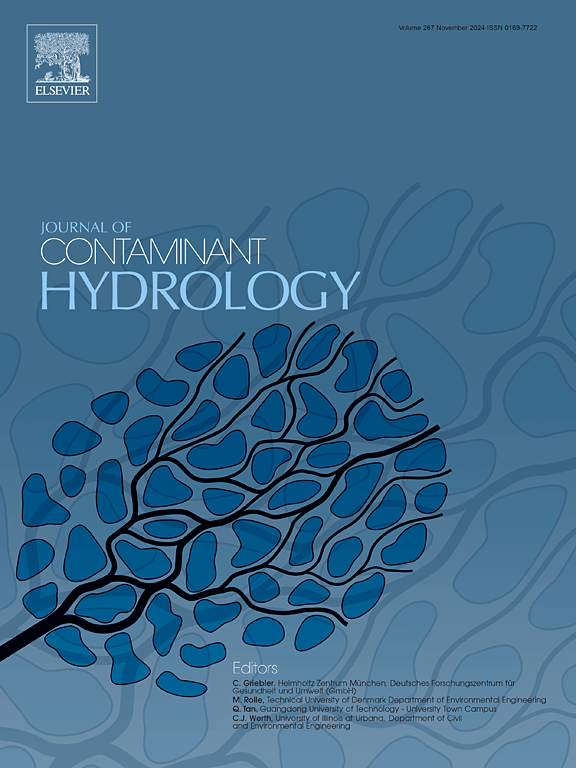Metal pollution in surface sediments of the Vembanad wetland: Seasonal variation, source apportionment, and human health risk assessment
IF 3.5
3区 环境科学与生态学
Q2 ENVIRONMENTAL SCIENCES
引用次数: 0
Abstract
This study examines the origins, distribution, and health impact of potentially toxic elements (PTEs) found in the surface sediments of Vembanad Wetland, a Ramsar site on India's southwest coast. Sediment from 14 sampling locations was seasonally analysed for Fe, Mn, Cu, Ni, Co, Zn, Cr, Pb and Cd. The average concentration of PTEs (mg/kg) follows the order: Fe (35,668.07 ± 20,082.98) > Mn (307.5 ± 36.71) > Zn (155.96 ± 99.45) > Cr (119.94 ± 79) > Ni (92.66 ± 32.69) > Cu (42.29 ± 17.26) > Pb (21.67 ± 11.65) > Co (20.64 ± 14.32) > Cd (2.21 ± 0.78). Higher average contamination factor (CF), enrichment factor (EF) and geoaccumulation index were observed for Cd (CF = 4.17, EF = 7.73, Igeo = 2.18) and Zn (CF = 4.85, EF = 2.44, Igeo = 0.38), indicating substantial anthropogenic enrichment. The average values of pollution indices such as PLI (1.49), TRI (11.69), mCd (15.1), and RI (251.69) indicate moderate to significant pollution. Average modified hazard quotient (mHQ) values revealed that Ni (3.19), Cr (2.76), Cd (1.99), and Zn (1.64) posed notable ecological risks. A potential health concern from prolonged exposure was indicated by the increased average total carcinogenic risk (TCR) values for Ni (9.24E-2), Cr (6.57E-2), and Cd (3.62E-2) in children. Multivariate analyses (PCA, PCC, HCA) suggested common contamination sources, with PCA-MLR confirming industrial discharge and agricultural runoff as dominant contributors. This study uniquely integrates seasonal variability, advanced pollution indices, and health risk evaluation, highlighting the urgent need for targeted management strategies in these sensitive aquatic systems.
文班纳德湿地表层沉积物金属污染:季节变化、来源解析及人体健康风险评价
本研究调查了在印度西南海岸拉姆萨尔湿地Vembanad湿地表层沉积物中发现的潜在有毒元素(pte)的来源、分布和健康影响。对14个采样点的沉积物进行了Fe、Mn、Cu、Ni、Co、Zn、Cr、Pb和Cd的季节性分析。pte的平均浓度(mg/kg)顺序为:Fe(35,668.07±200,082.98)>;Mn(307.5±36.71)>;Zn(155.96±99.45)>;Cr(119.94±79)>;Ni(92.66±32.69)>;Cu(42.29±17.26)>;Pb(21.67±11.65)>;Co(20.64±14.32)>;Cd(2.21±0.78)。Cd (CF = 4.17, EF = 7.73, Igeo = 2.18)和Zn (CF = 4.85, EF = 2.44, Igeo = 0.38)的平均污染因子(CF)、富集因子(EF)和地聚集指数均较高,表明存在较大的人为富集。PLI(1.49)、TRI(11.69)、mCd(15.1)和RI(251.69)等污染指数的平均值表明污染程度为中度至重度。修正后的平均危害商(mHQ)值显示,Ni(3.19)、Cr(2.76)、Cd(1.99)和Zn(1.64)具有显著的生态风险。儿童中Ni (9.24E-2)、Cr (6.57E-2)和Cd (3.62E-2)的平均总致癌风险(TCR)值增加,表明长期暴露可能引起健康问题。多变量分析(PCA, PCC, HCA)显示了常见的污染源,PCA- mlr证实工业排放和农业径流是主要污染源。该研究独特地整合了季节变化、先进的污染指数和健康风险评估,强调了在这些敏感的水生系统中迫切需要有针对性的管理策略。
本文章由计算机程序翻译,如有差异,请以英文原文为准。
求助全文
约1分钟内获得全文
求助全文
来源期刊

Journal of contaminant hydrology
环境科学-地球科学综合
CiteScore
6.80
自引率
2.80%
发文量
129
审稿时长
68 days
期刊介绍:
The Journal of Contaminant Hydrology is an international journal publishing scientific articles pertaining to the contamination of subsurface water resources. Emphasis is placed on investigations of the physical, chemical, and biological processes influencing the behavior and fate of organic and inorganic contaminants in the unsaturated (vadose) and saturated (groundwater) zones, as well as at groundwater-surface water interfaces. The ecological impacts of contaminants transported both from and to aquifers are of interest. Articles on contamination of surface water only, without a link to groundwater, are out of the scope. Broad latitude is allowed in identifying contaminants of interest, and include legacy and emerging pollutants, nutrients, nanoparticles, pathogenic microorganisms (e.g., bacteria, viruses, protozoa), microplastics, and various constituents associated with energy production (e.g., methane, carbon dioxide, hydrogen sulfide).
The journal''s scope embraces a wide range of topics including: experimental investigations of contaminant sorption, diffusion, transformation, volatilization and transport in the surface and subsurface; characterization of soil and aquifer properties only as they influence contaminant behavior; development and testing of mathematical models of contaminant behaviour; innovative techniques for restoration of contaminated sites; development of new tools or techniques for monitoring the extent of soil and groundwater contamination; transformation of contaminants in the hyporheic zone; effects of contaminants traversing the hyporheic zone on surface water and groundwater ecosystems; subsurface carbon sequestration and/or turnover; and migration of fluids associated with energy production into groundwater.
 求助内容:
求助内容: 应助结果提醒方式:
应助结果提醒方式:


